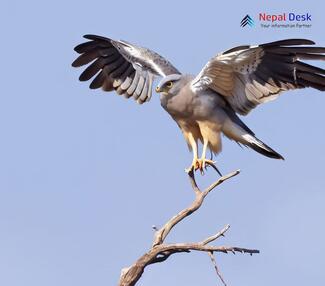The Pallid Harrier (Circus macrourus) is a breathtaking bird of prey, renowned for its elegant and agile movements while in flight. This intriguing raptor has captured the hearts of bird enthusiasts and conservationists alike, mainly due to its elusive behavior and infrequent sightings in certain areas. In this article, we'll dive into the captivating world of the Pallid Harrier and investigate its importance within Nepal's thriving ecosystem.
A Glimpse at the Pallid Harrier's Features
Medium-sized and sporting different plumage for males and females, the Pallid Harrier exhibits a striking appearance. Males boast a gorgeous greyish-blue hue with contrasting black wingtips, while females don a luscious brown coat accented by an eye-catching facial disk. The slender body shape and long wings equip the Pallid Harrier with the ability to masterfully hunt on the move, primarily focusing on small rodents and birds as prey.
An Overview of Habitat and Range
Pallid Harriers are known to breed across a vast expanse that includes Eastern Europe, Central Asia, and parts of North Africa. They prefer open grasslands, wetlands, and steppe terrain for nesting purposes. During migration periods, they journey far from their breeding zones to wintering grounds in Africa, the Indian Subcontinent, and some regions in Southeast Asia.
A Home Away from Home in Nepal
In recent times, Nepal has gained significance as an essential wintering haven for the elusive Pallid Harrier within South Asia. The assortment of natural landscapes present in Nepal - from lowland Terai plains to lofty Himalayan foothills - offers appropriate habitats that enable these raptors to thrive during their winter visit.
Prime locations for spotting this majestic bird in Nepal encompass Koshi Tappu Wildlife Reserve in Eastern Nepal, known for its riverine grasslands; Suklaphanta Wildlife Reserve which lies within the far-western Terai plains; and the central lowland's Jagadishpur Reservoir, which attracts a variety of grassland-dwelling avians.
Addressing Conservation Challenges
Regrettably, Pallid Harrier populations have seen a steady decline worldwide due to factors such as habitat loss, shifting agricultural practices, and human-related threats like poaching. As a consequence, this one-of-a-kind bird species has been classified as "Near Threatened" on the International Union for Conservation of Nature (IUCN) Red List.
To battle these challenges, various organizations are striving to protect suitable habitats and raise public awareness about the Pallid Harrier's existence in Nepal. Additionally, bird conservationists and aficionados are conducting regular monitoring efforts to gain a deeper understanding of the population dynamics and habitat needs of the Pallid Harrier in Nepal.
A Parting Thought
The enigmatic beauty of the Pallid Harrier graces Nepal's varied landscapes during wintertime. The country serves as an invaluable sanctuary for these mesmerizing raptors whose existence is subject to an uncertain future as a result of human-induced pressures. By delving into their ecology and distribution patterns in Nepal, we can collectively work towards preserving their habitats and ensure their captivating allure is appreciated by generations to come.




